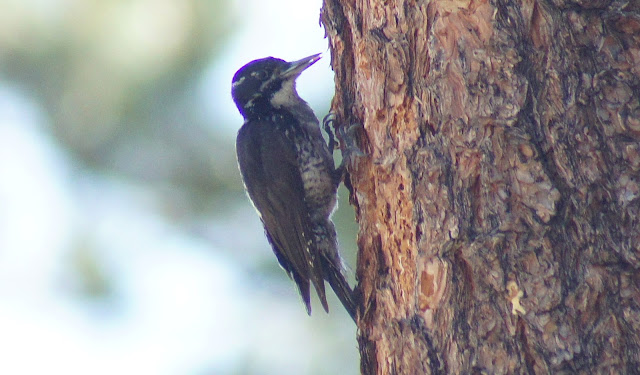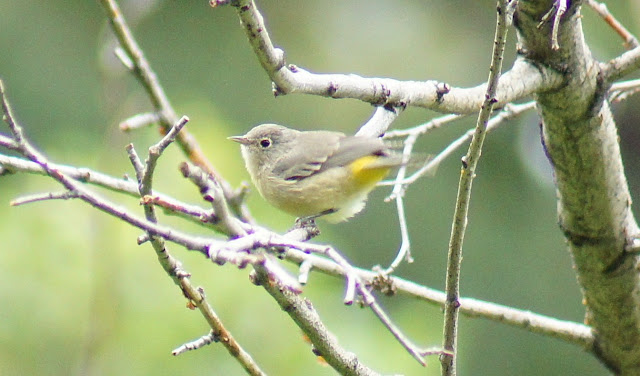I woke up thinking about going elsewhere, but for the third straight morning, I decided to start my day off in Greer today on July 22nd, 2013.
River Reservoir was my first stop, which is one of three Greer Lakes that neighbor each other. This scenic reservoir always brings in good memories, as in my early days of birding, I went here almost daily on Greer camping trips. And the birding is very fun here too.
River Reservoir
I don't often see Clark's Nutcrackers in the immediate area of the Greer Lakes, but every now and then, they'll dot the top of the pine trees.
Clark's Nutcracker
Ospreys are a very common sight around the lakes, with several different nests in the vicinity. The fisherman at the lakes are commonly entertained by the Osprey's close-to-flawless fishing efforts.
Osprey
Canada Geese are a pleasant sight at the lakes also, who make their presence known as they fly in with loud flight calls. This sound has woke me up in the morning countless times on past camping trips, when I slept in a tent at Rolfe C. Hoyer Campground. The geese would fly over en route to the lakes.
Canada Geese
The lakes also have a few trees full of nesting Double-crested Cormorants.
Double-crested Cormorant nesting tree
Besides the species tied in with the water habitats, the Greer Lakes are also in midst of ponderosa pine forests and grasslands, which produce all of the common ponderosa pine species, as well as grassland dwellers such as Eastern Meadowlark and Vesper Sparrow.
White-breasted Nuthatch
Eastern Meadowlark
After the stop at River Reservoir in the Greer Lakes area, I was still on a high from the Butler Canyon Nature Trail's birding outing on my first day here. I wanted to return, and so I decided to return. I wanted to see more woodpeckers, and continue on dirt roads north of the Butler Trail, where I once stayed in a cabin in 2000, which was really my first "real" birding trip that kicked off this hobby in the right direction.
After seeing 6 Williamson's Sapsuckers on the trail on the previous visit, the luck continued with 8 this time. When I pulled up to the trailhead, I saw the young female Williamson's Sapsucker again before I even got out the car. She was roadside, and was foraging in a pine. She was extra cooperative.
Williamson's Sapsucker (juvenile female)
Throughout the walk, I was able to find a few more adult male Williamson's Sapsucker. This dude was pretty cooperative.
Williamson's Sapsucker male
A short distance down on the path, a found another male Williamson's Sapsucker. This guy was very bright, but the pine needles in the way took my chances away of a great shot. Nevertheless, still a good memory!
On this hike, I also found at least 5 Three-toed Woodpeckers. Because of the many trees that have burned in the area, these guys are really seeming to be an easy bet to find here.
American Three-toed Woodpecker
This area is also filled with the song of the House Wren. These little guys can't be missed.
House Wren
Western Wood-Pewees are also very common
And the Pygmy Nuthatch is the most abundant
As I mentioned before, I hiked past the Butler Trail into an area I once stayed in. This area is great and looks over the Greer Area.
And this is the cabin I once stayed in, Lowell's Cabin. One of the best ever!
On this walk I also encountered a Downy Woodpecker, Hairy Woodpecker, Red-naped Sapsucker, and Northern Flicker to bring the woodpecker species count up to 6. A Great Horned Owl and several Olive-sided Flycatchers were also nice.
Acorn Lodge today has also had good birding.
Cordilleran Flycatcher
Hairy Woodpecker
American Robin
Mountain Bluebird
Young Mountain Bluebird
Brewer's Blackbird
"Audubon's" Yellow-rumped Warbler
My last outing of the day was a small one, but it was also a productive one. The place I chose was Benny Creek. Benny Creek is a lush riparian area that runs on both the north and south side of the 373. Both sides hold good birding opportunities with high elevation riparian habitats and surrounding pine and fir forest. It was later in the afternoon around 3 P.M. when I arrived here, and the activity was low at first. Once the sun light hit the area in midst of the dense monsoon clouds, bird life became a lot more active.
To start the walk off, a familiar sapsucker site over the last two days crossed my path. I'm sure you know what I'm about to say......
........Williamson's Sapsucker, another adult male (I'll photograph every one I see!)
The cloudy skies made shooting the sapsucker difficult, but the some of the other highlights were seen either at, close to, or below eye level. Some of these awesome highlights were mountain warblers!
Red-faced Warbler
Virginia's Warbler
MacGillivray's Warbler (horrible shot, but it was cool seeing it!)
And there were also a lot of creepers in the woods. Not the bad kind of creeper, but the brown feathered kind that is harmless.
Brown Creeper
But the best find I had on this walk was one of the better birds I have observed on this trip. I detected it's presence by a strange insect-like trill. If one had never heard this sound before, one would definitely pass it off as an insect. The reason I learned about this call is because I luckily found and filmed this bird for the first time in 2007, ironically, at Benny Creek. Strangely, this call is made by a fledgling Northern Pygmy-Owl. As I was about to head back and was close to my truck, I heard that insect-like trill. I knew what it was and I went back into the direction of the sound. This was at Rosey Creek, a small creek that flows into Benny Creek. As I got closer to the sound, I realized that one of them was further back than the first, so there where at least two fledgling Northern Pygmy-Owls. I searched for about 20 minutes without a visual until I looked up in a dead tree in the middle of the ponderosa trees (the only one I didn't check and the only one I didn't think I'd find an owl), and saw a Pygmy shape.
It was an adult Northern Pygmy Owl, and I watched it while the fledglings called. I never did see the fledglings, but it was cool to note that these owls are breeding in this area. I will probably be back to the location for more!
Northern Pygmy-Owl
As I was looking for the owls, I was also glad to see and hear my first Common Nighthawk of the year! I haven't seen a Common Nighthawk in at least two years.
Following Benny and Rosey Creeks, I went on an evening mammal search to Sunrise with my family. Besides seeing the cool hoofed mammals, I found a Swainson's Hawk perched by the Sunrise General Store. Swainson's Hawks are very local summer residents in the White Mountains.
Here are the mammals!
Pronghorn Antelope
Elk
Mule Deer














































So cool...
ReplyDeleteThose Woodpeckers are something else, but man your shots of the Wren and Cordilleran are Nat'l Geographic sharp. Looking forward to more!